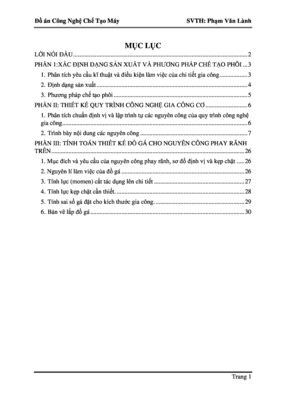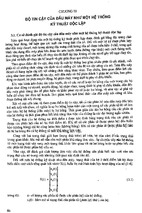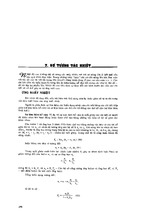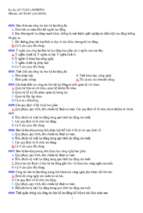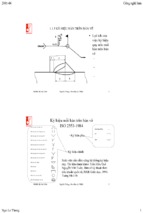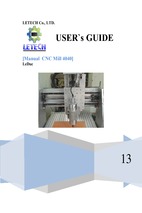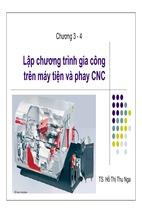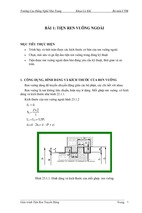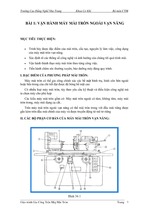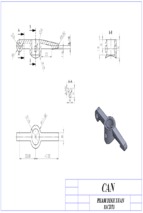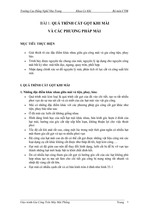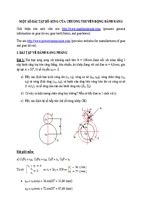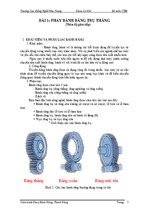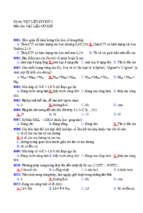MARINE
DIESEL ENGINES
~~rtr::-:::('7Ii='1H-t=1>.---t Fuel
injector
Precombustion
chamber
Pitch
control
Glow plug
Pitch control
lock
Cou nterweig hts
A single cylinder, 4-cycle marine diesel engine of traditional design (a Sabb
type 0, 10 h.p., courtesy of Sabb Motor A.S.). This illustration shows clearly
the principal components to be found in any diesel engine.
DIESEL ENGINES
Maintenance, Troubleshooting, and Repair
Nigel Calder
International Marine Publishing Company
Camden, Maine
© 1987 by Highmark Publishing, Ltd.
All rights reserved. Except for use in a review, no part of this
book may be reproduced or utilized in any form or by any means,
electronic or mechanical, including photocopying, recording, or
by any information storage and retrieval system, without written
permission from the publisher.
Published by International Marine Publishing Co., a division of
Highmark Publishing, Ltd., 21 Elm Street, Camden, Maine
04843.
Typeset by Typeworks, Belfast, Maine.
Printed and bound by Rand McNally, Taunton, Massachusetts.
10 9 8 7 6 5 4 3 2
1
Library of Congress Number 87-2918
ISBN Number 0-87742-237-0
To Terrie,
who never minds getting grease under her fingernails
,
,
I
Contents
One
Two
Three
Four
Five
Six
Seven
Eight
Nine
Ten
Eleven
Twelve
Thirteen
Fourteen
Fifteen
Appendices
Preface
ix
Introduction
xi
Principles of Operation
1
The Air Supply
10
Combustion
14
Fuel Injection
17
Governors
23
Cooling
26
Exhausts
30
Cleanliness is Next to Godliness
32
Troubleshooting, Part One-Failure to Start
Troubleshooting, Part Two
54
Overhauls, Part One-Decarbonizing
64
Overhauls, Part Two
94
Marine Gearboxes
111
Engine Installations
118
Engine Selection
127
A Tools
137
B Spare Parts
139
C Useful Tables
141
Glossary
145
Index
149
vii
40
Preface
tical mechanics represents a mix that. has
worked well for me over the years. Although
my approach may help the boat owner see
trouble coming and nip it in the bud before
his engine breaks down, it may leave some
readers hungry for more theory. To them,
I'll suggest the library; it contains numerous
books that deal in great depth with all aspects
of thermodynamics.
Although this book has been written with
engines from 10 to 100 h.p. in mind, the
principles are virtually the same as those
associated with engines of hundreds or even
thousands of horsepower. The information
in this book applies to just about all diesels.
Sources of data and drawings are indi
cated throughout the book, but I. would,
nevertheless, like to thank all those who have
helped me, in particular, Paul Landry and
Bill Osterholt for their many suggestions,
and the companies that provided drawings
and other help. They are: Borg Warner
Automotive, Caterpillar Tractor Co., the
AC Spark Plug Division of General Motors,
ITT/Jabsco, Lucas CAV Ltd., Perkins En
gines Ltd., Pleasurecraft Marine Engine
Co., Sabb Motor A.s., Garrett Automotive
Products Co., Volvo Penta, Holset Engi
neering Co. Ltd., and United Technologies
Diesel Systems.
I extend my thanks to Dodd, Mead and
Company for permission to use the material
from Francis S. Kinney's Skene's Elements
This book provides the basic information
necessary to select, install, maintain, and
carry out repairs on a marine diesel engine.
It is neither a simple how-to book nor a tech
nical manual on the thermodynamics of
internal-combustion engines. Rather, it falls
somewhere between the two.
This reflects my own experience as a self
taught mechanic with some 20 years' experi
ence on a variety of engines, from 10 to
2,000 h.p. With specific enough instructions
it is perfectly possible to dismantle an engine
and put it back together again without hav
ing any understanding of how it works.
Troubleshooting that engine without a basic
grasp of its operating principles, however, is
not possible.
In order to grasp these operating prin
ciples, just a little of the most basic theory
behind internal-combustion engines-more
than found in many how-to books-is all
you really need to know. It is also possible to
be a whiz at theory and a useless mechanic.
You'll find not a single intimidating mathe
matical formula in this book. What I have
tried to do is present the general theory
underlying diesel engine operation, but only
what is necessary to provide a good under
standing of the practical side of diesel engine
maintenance. My objective is to help turn
out competent amateur mechanics, not auto
motive engineers.
This particular blend of theory and prac
ix
----------
----~
.....-
- . - -.........
......
---~---~-
..- -
~-~.~
~-~~.-
......- -
x
Preface
of Yacht Design, and to Reston Publishing
Company for information contained in
Robert N. Brady's Diesel Fuel Systems.
Dennis Caprio, my editor, has made a
mass of detailed suggestions that have im
proved this book greatly. Jonathan Eaton at
International Marine has always been helpful
and encouraging. Any errors remaining are
solely mine.
Nigel Calder
Ponchatoula, Louisiana
June 1986
Introduction
engine works will be the key to troubleshoot
ing the problem. My third objective is to out
line troubleshooting techniques that promote
a logical, clearheaded approach to solving
the problem.
The fourth section of the book goes
through various maintenance, overhaul, and
repair procedures that can reasonably be
undertaken by an amateur mechanic, and
one or two that should not really be at
tempted but which might become necessary
in a dire emergency. Major mechanical
breakdowns and overhauls are not included.
This kind of work can only be carried out by
a trained mechanic.
The book is rounded out with a consid
eration of correct engine installation pro
cedures and some criteria to assist in the
selection of a new engine for any given boat.
Much of the last section may throw some
light on problems with an engine already
installed.
There is no reason for a boat owner not
to have a long and troublefree relationship
with a diesel engine. He only needs to pay
attention to routine maintenance, have the
knowledge to spot early warning signs of
impending trouble, and have the ability to
correct small problems before they become
large ones.
For very good reasons the diesel engine is
now the overwhelming choice for sailboat
auxiliaries, and it is becoming more popular
in sport fishing boats. Diesels have an un
rivaled record of reliability in the marine
environment; they have better fuel economy
than gasoline engines; they are more effi
cient at light and full loads; they emit fewer
harmful exhaust pollutants; they last longer;
and they are inherently safer because diesel
fuel is far less volatile than gasoline.
Despite its increasing popularity, the
diesel engine is still something of a mystery,
propagated in large part by the differences
that distinguish it from the gasoline engine.
The first objective of this book, then, is to
explain how a diesel engine works, to define
new terms, and remove the veil of mystery.
If the owner of a diesel engine has a thor
ough understanding of how it works, then he
will fully grasp the necessity for certain
crucial aspects of routine maintenance and
the expensive consequences of habitual ne
glect. Properly maintained, most diesel en
gines will run for years without trouble,
which leads to my second objective-to
drive home the key areas of routine main
tenance.
If and when problems arise, they nor
mally fall into one or two easily identified
categories, and your knowledge of how the
xi
- - _.... _ - - _.... -_._.... - - -
--_ - - _
...
... -
--
- - _.... - - . _....
- -..
_
.....
--
MARINE
DIESEL ENGINES
Chapter One
Principles of Operation
t
I
I
To understand the operation of a diesel
engine, you must know a little bit about
heat, pressure, and the behaviour of gases in
a sealed chamber.
will feel the same as a lO-pound block at the
same temperature, but the one-ton block will
contain 200 times more Btus of heat energy
than the 10-pound block.
Heat
Pressure
All solids, liquids, and gases {all "bodies"}
contain heat to a greater or lesser extent.
Theory states that to remove all heat from a
body it would have to be cooled to minus
460°F, a temperature known as absolute
zero. This is a purely theoretical calculation
that has never been achieved in practice. The
higher the temperature above -460°F, the
more heat a body contains. This quantity of
heat can be measured. The unit of measure
ment is not degrees Fahrenheit or Celsius
(centigrade), but something called British
thermal units (Btus).
One Btu is defined as the quantity of heat
required to raise the temperature of one
pound of water one degree Fahrenheit.
Therefore, adding 20 Btus to one pound of
water will raise the temperature from 140 OF
to 160 OF. The removal of 20 Btus will cool it
back down to 140°F.
The Btu is used to measure quantities of
heat; the thermometer measures the intensity
of the heat of a body, what we perceive as
feeling cold or hot, but the temperature of a
body tells us very little about how much heat
it contains. A one-ton block of iron at 90 OF
Pressure is commonly measured in pounds
per square inch absolute (psia) and pounds
per square inch gauge (psig). Any measure
ment in pounds per square inch gauge (psig)
is 14.7 pounds lower than the same measure
ment in pounds per square inch absolute
(psia). In other words, psig
psia
14.7.
From where do we get l4.7?
Atmospheric pressure. The earth is sur
rounded by an envelope of gases (air, the at
mosphere). Although we have no sensation
of weight, these gases do in fact have weight.
Imagine a pile of 10 books, one atop the
other. The top two or three might only weigh
a pound or so, but farther down the stack
the cumulative weight of books is a great
deal more.
It is just the same with the atmosphere.
The outer layers bordering on space weigh
almost nothing and exert very little down
ward pressure. At sea level, however, the ac
cumulated mass of the atmosphere exerts a
pressure of 14.7 pounds per square inch on
the surface of the earth. This pressure de
creases by approximately 0.5 psi with every
1,000 feet of altitude.
1
2
Marine Diesel Engines
Gauge and absolute pressure. Because we
are born and raised in this atmosphere, it be
comes the norm for us, and we have no sen
sation of the pressure it exerts-we are ad
justed to an ambient pressure of 14.7 psi. It
therefore makes sense to calibrate pressure
gauges to zero at atmospheric pressure, and
then they will register any deviation from the
ambient pressure. This is what is meant by
pressure per square inch gauge (psig, com
monly abbreviated to psi). On the other
hand, a gauge which is calibrated to measure
the real, or actual, pressure will have to reg
ister 14.7 psi at atmospheric pressure. This is
what is meant by pressure per square inch
absolute (psia).
Vacuum. Let us imagine taking our two
gauges into space. As we rise higher into the
Earth's atmosphere, the pressure steadily de
creases. When we finally enter deep space,
the gauge calibrated in pounds per square
inch absolute will read zero-a perfect
vacuum. What about the other gauge? It has
been calibrated to read zero when the pres
sure is actually 14.7 psi. Now, as we reach
true zero, this gauge will have to read minus
14.7 psi, but in practice another scale is used
to indicate readings below atmospheric pres
sure. This is inches of mercury (abbreviated
to Hg). A perfect vacuum (-14.7 psi) is
equivalent to - 29.2 inches of mercury, and
this is what the gauge will read in deep space.
In other words, 30 inches Hg is roughly
equivalent to 15 psi. Therefore a pressure
one pound below atmospheric pressure will
show - 2 inches Hg; 5 pounds below atmos
pheric pressure, - 10 inches Hg; and so on.
Pressure measurements in engine work
are made almost exclusively in pounds per
square inch gauge, or psi. Because parts of
an engine commonly fall below atmospheric
pressure (e.g., the engine air-inlet manifold
on many engines), it is sometimes necessary
to deal with partial vacuums. Generally
speaking the only time that absolute pressure
is introduced is when considering the effects
of high altitude on engine performance.
Gases
If a gas is put in a sealed cylinder and then
the volume of the cylinder is reduced (e.g.,
by forcing a piston up one end) two things
happen: the pressure increases, and the tem
perature rises. The rise in temperature is not
due to the addition of heat; it results from
the concentration of the heat already in the
gas into a smaller space. In other words,
after compression the gas contains the same
amount of heat (Btus) as before compres
sion, but these Btus have been squeezed into
a smaller space, creating a rise in tempera
ture (sensible heat). A somewhat loose anal
ogy could be drawn from putting a heater in
a large room and a similar heater in a small
room. The small room will become hotter
even though the two heaters put out the same
number of Btus, because this heat is concen
trated into a smaller space.
The relationship between rising pressure
and temperature when a gas is compressed is
a direct one. A given rise in pressure will
create a given rise in temperature. The corol
lary also holds true: if a gas is heated in a
sealed chamber, its pressure rises with its
temperature. When an unconfined gas is,
heated it expands, but when expansion is
prevented, the pressure rises.
These relationships between pressure and
temperature also hold in reverse. If the pres
sure of a gas is reduced, its temperature will
fall in direct proportion, and if its tempera
ture is reduced, its pressure will drop in
direct proportion.
The diesel engine
All engines, gasoline or diesel, consist of one
or more cylinders closed off at the top with a
cylinder head. Beneath the cylinder is a
crankshaft, so called because of its offset pin
and cheeks that make up the crank. A con
necting rod ties the crankshaft to a piston
that moves up and down in the cylinder. The
connecting rod has a bearing at each end,
and these allow it to rotate around a pin in
the piston (piston pin or wrist pin) and the
crank. As the piston moves up and down,
the crankshaft turns (see Figure 1-3).
Most engines contain the following basic
components: inlet and exhaust valves at the
top of the cylinder to allow gases in and out
at specific times; levers known as rockers to
Principles oj Operation
0---
3
Aftercooler (intercooler)
Rocker arm
--
---
·Turbocharger - - - - '
Valve
Injector
Valve guide
Push rod
--~-----==---
--
"Wet" cylinder liner --..::::!!I!I1IIiIIi
Piston
Piston rings
Camshaft
Piston pin
"Jerk"-type fuel injection
pump
Heat exchanger - - - -
Connecting rod
Crank end bearing
Main bearing cap
Oil filter - - - - - -
Oil pump
Figure 1-1. Cutaway view of a modern turbocharged diesel engine-the
Caterpillar 3406B in-line 6. (Courtesy Caterpillar Tractor Co.)
~
~.:
r
open the valves; push rods to push up one
end of the rockers; springs located under the
end of each rocker opposite the push rod to
close the valves; and a shaft with elliptical
protrusions on it called cams. As this cam
shaft rotates, the high point of the cam
moves the push rod up, which pushes on the
rocker and opens the valve. When the cam
shaft rotates to the low point of the cam, the
valve spring pushes up on its end of the
rocker, closing the valve and forcing the
push rod down. The camshaft is driven by
the crankshaft so that the opening and clos
ing of the valves can be precisely coor
dinated, or timed, with the movement of the
piston in the cylinder (see Figure 1-4).
In some engines, the camshaft is located
within the cylinder head atop the valves and
rockers. The cams act directly on the
rockers, and the engines have no push rods.
These engines are known as overhead cam
shaft types.
In order to ensure that the piston makes a
gastight seal against the side of its cylinder, it
is given a number of spring-tensioned rings
that push out against the cylinder wall.
These are piston rings. The cylinder itself is
either a machined bore in a cast-iron block
or a sleeve, or liner, pushed into the block.
Water contained in a space called the water
jacket circulates around the sleeve to keep it
cool. In diesel engines, two types of sleeve
are used: a wet liner, which is in direct con
tact with the cooling water and merely en
gages the block at its top and bottom where
it is sealed off; and a dry liner, which is in
contact with the block at all points (see
Figure 1-5).
-
.------~-------------------- ............
......
4
Marine Diesel Engines
springs
Valve
Removable valve seat
Cylinder head
Cylinder head gasket
Cylinder block (in-line)
Cylinder liner
Crankshaft
Connecting rod
cap
·Wef'-type
cylinder liner
Rings
Piston
Piston pin
Figure 1-2. Engine parts. (Courtesy Caterpillar Tractor Co.)
Principles of Operation
Cylinder
~~)
...--.....
Piston
5
Piston pin
Connecting rod
Figure 1-3. Converting reciprocal motion to rotary motion.
And last, in a gasoline engine a spark
plug is located in the top of the cylinder; in a
diesel engine its place is taken by a fuel
injector.
Diesel engines are either 4-cycle or
2-cycle. The differences will become clear in
a moment. Let us first look at a 4-cycle
engine.
4-cycle diesel
1. Starting with the piston at the top of
its cylinder, the inlet valve opens. The crank
shaft turns, pulling the piston down the cyl
inder, which creates a partial vacuum. This
causes air to be sucked into the cylinder (see
Figure 1-6).
2. When the piston reaches the bottom
of the cylinder, the inlet valve closes, which
traps the air that has been drawn into the cyl
inder. This completes the first, inlet, stroke
of the four cycles. (A stroke is the movement
of the piston from the top to the bottom of
its cylinder, or vice versa.)
3. The piston is now pushed back up its
cylinder by the crankshaft, compressing the
trapped air. As pressure rises, so too does
the temperature. With the piston back at the
top of its cylinder, pressure in a diesel
engine's combustion chamber is raised to
500 psi or more, and this in turn raises the
temperature of the compressed air in the cyl
inder to 850 to 1,200 of. This completes the
second, compression, stroke of the four
cycles.
4. Diesel fuel is sprayed into the cylinder
through the injector. The intense heat of the
compressed air in the cylinder causes the fuel
to catch fire. No ignition system is required,
which is one of the principal differences
from a gasoline engine. The burning fuel in
creases the temperature in the cylinder,
which raises the pressure of the gases even
higher, generally by around 250 psi.
5. The increased pressure pushes the
piston back down the cylinder. For the first
time the piston is pushing the crankshaft and
Rocker arm
Valve spring
Main
bearing
Connecting rod
Crank end
bearing
Connecting rod
cap
Crankcase
Main bearing cap
~~~~s:s:l.
Figure 1-4. Principal components in a diesel
engine.
6
Marine Diesel Engines
Cylinder liner
(partially removed)
Top of liner makes
watertight seal in
top of block
Bottom of cylinder finer has
"0" rings which seal in base of block
Figure 1-5. A "wet" cylinder liner.
not the other way around. This is the third,
power, stroke of the 4-cycle engine. As the
piston moves down the cylinder, it rapidly
increases the volume of the cylinder, causing
the pressure to fall, which causes the temper
ature to decrease.
6. When the piston reaches the bottom
of the cylinder, the exhaust valve opens, and
as the piston comes back up the cylinder
(pushed by the crankshaft once again), it
forces all of the burned gases out the ex
haust. This is the fourth, exhaust, stroke.
7. When the piston reaches the top of the
cylinder once again, the exhaust valve closes,
the inlet valve opens, and we are back at the
beginning of the four cycles.
2-cycle diesel
A 2-cycle engine operates in basically the
same fashion, but the processes are con
densed into two strokes of the piston, once
up and once down the cylinder, instead of
four. Here's how it works.
1. Begin with the power stroke. The pis
ton is at the top of its cylinder, which is full
of hot compressed air. The fuel is injected,
and ignites. The rising temperature and pres
sure drive the piston back down the cylinder
(see Figure 1-7).
2. As the piston moves down, pressure
and temperature fall in the cylinder. When
the piston nears the bottom of its stroke, the
exhaust valves open. (Two-cycle engines gen
erally have two exhaust valves per cylinder,
for reasons which will be explained later.)
Most of the exhaust gases rush out of the cyl
inder.
3. Just after the exhaust valves open,
and as the piston continues to move down
(still on its first stroke), it uncovers a series
of holes, or ports, in the wall of the cylinder.
The exhaust valves are still open. Fresh air
under pressure is blown in through these
ports, driving the last of the exhaust gases
out of the exhaust valves and filling the cyl
inder with clean air.
4. The piston has now reached the bot
tom of the cylinder and is on its way back
up. As it moves, it blocks off the inlet ports,
and at about the same time the exhaust
valves close, trapping the new charge of
fresh air in the cylinder. Compression
begins.
5. The piston is driven to the top of the
cylinder by the crankshaft, compressing the
air, the diesel fuel is injected, and the cycle
starts over. The piston has traveled once
down the cylinder and once up.
A diesel engine produces power only
when it is burning fuel. It is possible both to
calculate the heat content in Btus of the fuel
burned and to figure the Btu equivalent of
the horsepower produced (l h.p.
2,544
Btus). In a perfect engine all the heat from
the burning fuel would be converted into
useful energy; as the piston descended on the
power stroke, the pressure and temperature
in the cylinder would decrease to exactly the
same values that existed at the beginning of
the cycle.
In practice, considerable heat and pres
sure remain at the end of the power stroke,
and must be removed to enable a fresh
charge of air to be drawn in and to prevent
the build-up of dangerously high tempera
tures that would damage the engine. The net
result is that the average diesel engine con
verts into usable energy just 30 to 40070 of the
heat generated. The rest is dissipated as cool
ing water, 25%-30%; exhaust gases,
25%-30%; and internal friction, radiation
from the engine block, and related losses,
10%. As bad as this sounds, it is still con
siderably more efficient than a gasoline
engine.
Principles of Operation
7
CYCLE 2
CYCLE 1
Compression stroke
(Both valves closed)
Inlet (suction) stroke
(Inlet valve open)
CYCLE 3
CYCLE 4
Power stroke
(Both valves closed)
Exhaust stroke
(Exhaust valve open)
Figure 1-6. Operation oj a 4-cycle engine.
As previously mentioned, the diesel
engine has no ignition system. The injected
fuel is ignited by the temperature rise asso
ciated with compressing air to a high pres
sure. The ignition point of diesel fuel is
about 750°F, but in practice, most diesel
engines compress the air until a temperature
of about I,OOO°F is achieved.
Compression ratio is the term used to de
scribe the degree to which the air charge is
compressed in the cylinder. Specifically, it
indicates the volume of the cylinder when the
piston is at the bottom of its stroke relative
to the volume of the cylinder when the piston
is at the top of its stroke. For example, a
compression ratio of 16 to 1 (generally writ
ten as 16:1) tells us that when the piston is at
the bottom of its stroke the cylinder has a
volume 16 times greater than when the
piston is at the top of its stroke-the inlet air
is being compressed to one-sixteenth its
original volume.
The minimum practical compression
ratio to raise the inlet air temperature suffi
ciently for combustion is around 14: 1 (see
Figure 1-9), and most modern small diesel
8
Marine Diesel Engines
CYCLE 1
Injection/power stroke.
Exhaust valves open
Inlet ports uncovered
CYCLE 2
Inlet ports covered
Exhaust valves closed
Compression
Figure 1-7. Operation of a 2-cycle engine.
engines of the kind under discussion here
have compression ratios of 17: 1 to 23: 1. This
is in sharp contrast to gasoline engines,
which generally have compression ratios of
around 7: 1 to 9: 1, resulting in compression
pressures of 80 to 130 psi.
It is this difference in compression ratios
that principally accounts for the increased
efficiency of a diesel engine over a gasoline
engine, for it means that the gases of com-
bustion have a greater degree of expansion
on the power stroke. The more gases ex
pand, the more they cool, which is to say
that a diesel engine converts a greater pro
portion of the heat of combustion into
useful work than does a gasoline engine-a
diesel engine is more' 'thermically efficient."
The rate that thermal efficiency increases
as compression ratios are increased, how
ever, slows down. At some point, the prob
Principles of Operation
800
c:
o
Heat converted to
usable power
.~
9
.1100
700 '-.- - - " - - j ,
--t--t--+--iT---t--L
I
600:-:-+--L--t----,f---Y''--+---:l~,1000
I
u::
P;
~500f---+-+--+
~
P;
8
~ 400
m
2! 300 -+---A--+r - .- \ - - - - - ' .
Heat lost to
cooling
system
Heat lost to
exhaust
lems created by the extra stresses outweigh
the benefits of additional thermal efficiency,
and this probably occurs close to a compres
sion ratio of 20: 1.
Why not increase the compression ratio,
and therefore the thermal efficiency, of
gasoline engines? The answer is that on a
gasoline engine the fuel charge is drawn in
through the carburetor with the air, and is
compressed with it. A higher compression
ratio would cause ignition to occur before
the piston reached the top of its stroke,
rapidly destroying the engine. Compression
ratios must be kept low enough to prevent
the temperature from reaching the ignition
point. Then, at the appropriate moment, a
spark ignites the air/fuel mixture-which is
why gasoline engines have an ignition
system.
You may think that fuel injection on
gasoline engines could be made to serve the
same function as fuel injection on diesel
engines, allowing much higher compression
ratios to be used and therefore considerably
improving the efficiency of the engine. Gas
oline, however, is far more volatile than
900 ~
[
E
r-i
i
ePOO
a.
•
f-.
~
--,t<+--+--I-+-f---+--+---I--j 800
100i-'-+---r~T--+--t---I-~~
L-~_~L--L__L_-L~_-L~700
16 18
Compression ratio
Figure 1-8. Heat utilization of a diesel
engine.
•
20
22
Figure 1-9. Approximate temperatures and
pressures at different compression ratios.
diesel fuel, and if injected into the super
pressurized and heated air found in a high
compression engine would explode forceful
ly enough to damage the engine. Although it
is hard to visualize in an engine turning over
at 3,000 revolutions per minute (r.p.m.) with
a combustion period for each power stroke
of less than 0.01 second, the injected diesel
fuel is burning at a controlled rate rather
than exploding, which substantially reduces
the shock loads on the engine. (If the fuel
does indeed fail to burn at the correct rate,
problems result, as we shall see later.)
The high compression ratios of a diesel
engine subject all the many components to
loads that are greater than those in a gasoline
engine. As a result, diesel engines have to be
far more solidly constructed, which accounts
for the increased weight and cost of most
diesel engines over gasoline engines of the
same power output. In recent years, how
ever, tremendous advances in metallurgy
and engine design have enabled drastic
weight reductions to be achieved on many
diesels, considerably narrowing this power
to-weight gap.
Chapter Two
The Air Supply
3.36123 x 100
Air is composed of about 23010 oxygen by
weight (21 % by volume). The rest is nitrogen
and other gases. The idea of air having
weight is sometimes a little hard to grasp,
but if you refer back to the definitions of ab
solute and gauge pressure in Chapter 1 you
will recall that at sea level the atmosphere ex
erts a pressure of 14.7 psi on the earth's sur
face. This pressure is created by the accumu
lated weight of the air surrounding the earth.
At sea level, and at 60 OF, one cubic foot of
air weighs approximately 0.076 lb. When the
temperature rises, air expands, and the
weight of a cubic foot of air decreases. This
is of some significance for the operation of
diesel engines.
Oxygen is the only component of air that
is active in the combustion process of an en
gine-the burning of diesel fuel is actually a
chemical reaction between the oxygen in the
air and hydrogen and carbon in the fuel. The
hydrogen combines with oxygen to form
water; the carbon combines with oxygen to
form carbon dioxide and, on occasion, car
bon monoxide. These chemical reactions
release a considerable amount of light and
heat.
Although diesel fuels vary somewhat in
their composition, in general about 3.36 lbs.
of oxygen are required to completely burn 1
lb. of diesel fuel. Given that air is only 23010
oxygen by weight, this means that approxi
mately
= 14.5Ibs.
of air is needed to burn a single pound of
fuel. If, at the atmospheric pressure of 14.7
psi and at 60 of, a cubic foot of air weighs
0.076 lb., our 14.5 lbs. of air translates into
14.5/0.076 = 190 cubic feet of air.
If diesel fuel weighs about 7.5 lbs. per U.S.
gallon, we need
190 x 7.5 = 1,425 cubic feet
of air to burn that one gallon. At higher tem
peratures, higher altitudes, or both, air is
less dense and even larger volumes are
needed to burn a gallon of diesel.
You won't have to remember any of these
figures-the purpose in setting them down is
to impress upon you the huge quantities of
fresh air required for the effective operation
of a diesel engine.
The weight of air that can be drawn into
a diesel engine more or less determines its
power output. Broadly speaking, more air
pulled in equals more fuel burned and more
heat generated, which results in more power
from the engine. Engineers must do every
thing possible to avoid restricting the flow of
air to the engine. Large air filters are gen
erally fitted to increase the surface area
through which the air is drawn; air inlet
pipes and manifolds are designed with as few
bends as possible; and on 4-cycle engines the
10
--
- - - - - - - - - - - -... --~.- .....
------
- Xem thêm -


